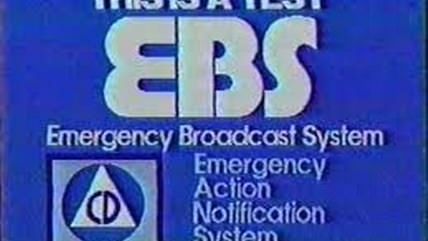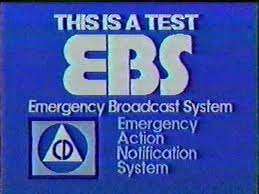Unstoppable Messages from the President, Now Coming to Your Smart Phone!


I un-fondly remember annoying Emergency Broadcast System tests interrupting my childhood television shows back in the days when such an intrusion could mean that you'd missed the punch line or even a chunk of plot. The annoying shriek and repeated "if this had been an actual emergency …" could drive my short-tempered self into a simmering rage at a tender age. What I didn't know until recently (how could I miss this?) is that the equivalent exists for smart phones, and you can't escape those damned Wireless Emergency Alerts, either.
According to the Federal Communications Commission:
WEA (formerly known as the Commercial Mobile Alert System (CMAS) or Personal Localized Alerting Network (PLAN)) is a public safety system that allows customers who own certain wireless phone models and other enabled mobile devices to receive geographically-targeted, text-like messages alerting them of imminent threats to safety in their area. The technology ensures that emergency alerts will not get stuck in highly congested areas, which can happen with standard mobile voice and texting services. WEA was established pursuant to the Warning, Alert and Response Network (WARN) Act.

The Warning, Alert and Response Network (WARN) Act passed in 2006, shoehorned into the Safe Accountability for Every Port Act of 2006 (SAFE Act).
Wireless providers don't have to participate, but all of the big ones have fully opted in, including AT&T, T-Mobile, Sprint Nextel and Verizon. You can find a list of participants here (XLS).
If your provider has opted in, is there any way for you to opt out? Well … A little. Says the FCC:
Alerts from WEA cover only critical emergency situations. Consumers will receive only three types of alerts:
- Alerts issued by the President
- Alerts involving imminent threats to safety or life
- Amber Alerts
Participating carriers may allow subscribers to block all but Presidential alerts.
One does not muzzle the emperor, of course.
Not all phones are yet equipped to receive the Wireless Emergency Alerts and their "unique attention signal and vibration, which is particularly helpful to people with hearing or vision-related disabilities," but you can count on receiving inescapable presidential missives within an upgrade or two.
Editor's Note: As of February 29, 2024, commenting privileges on reason.com posts are limited to Reason Plus subscribers. Past commenters are grandfathered in for a temporary period. Subscribe here to preserve your ability to comment. Your Reason Plus subscription also gives you an ad-free version of reason.com, along with full access to the digital edition and archives of Reason magazine. We request that comments be civil and on-topic. We do not moderate or assume any responsibility for comments, which are owned by the readers who post them. Comments do not represent the views of reason.com or Reason Foundation. We reserve the right to delete any comment and ban commenters for any reason at any time. Comments may only be edited within 5 minutes of posting. Report abuses.
Please to post comments


Comcast once interrupted the Super Bowl for one of these tests. It was an amazing thing.
The President cares about you peons. Why do you resist his love?
It's fucking infuriating.
It's a piercing alarm, even when I have the sound turned off. It displays an amber alert which then is utterly unrecoverable. The most recent one was when I was in a meeting, and it not only disrupted the meeting, but afterwards I had no idea what the alert was!
It's horribly designed, and I wish I knew how to disable it.
Looks like an opportunity for a new app. Perhaps we can call it "WEAk"
Amber alerts are BS. I remember one recently, a child had been abducted in Valdosta, way the hell down by the Florida border, so the Amber alert was for State of Georgia, just in case the abductor thought he could hide out unnoticed in Rabun County (up by N and SC) I guess.
Fortunately my phone hasn't had this junk show up yet.
Any evidence that the Silver Alerts work well enough to prevent collisions?
I'm glad that the other color code system got dropped, though. NYC never got out of orange.
And most of the Amber alerts turn out to be dads fed up with a system that assrapes them in custody disputes taking matters in their own hands. There is no reason to send an alert my way. I am not going to get involved in a domestic matter that is none of my business.
And here's why MRA is so easy to marginalize. No, it's not enough to complain about the family court system and work for reform, we have to excuse violent crime and pretend that there's never situations where denying an abusive father access to their child is justified.
I'm checking into ROMS for android that don't have the software. With all this spying and crap like this, I am trying to find a way to keep my cell phone and some modicum of privacy.
Anyone know of any encrypted ROMS or such?
CyanogenMod (CM) is working on a per app incognito mode, but that's the closest thing I know of to an encrypted ROM.
Would CyanogenMods allow you to delete the emergency alert messages?
I have not installed CM on my Android phones, but will with the next one.
I just got an iphone last week. Shortly after I was woken at 4AM by an ungodly shrieking.
Apparently there was a flash flood warning somewhere nearby.
I DON'T FUCKING CARE. Who even lives in a flood zone around here? Nobody I know...
If I could set it to warn me of nothing but tornadoes, I would, but I can't, so next morning I found out how to disable everything.
What kind of alerts has the president ever issued directly?
"The Wookie has gas!!!1! Abandon the White House! Abandon the White House!!"
I laughed.
How soon they forget:
Gun control fails in Senate.
Participating carriers may allow subscribers to block all but Presidential alerts.
Is it asking too much to see a few examples of "Presidential alerts" before this stuff is implemented?
"This is Your President. We are under nuclear attack. It has been an honor serving you."
"This is Your President. There are some who claim that the so-called IRS scandal goes all the way to the White House. As you know, I have welcomed this debate, but the time for such discussion is now over."
"This is Your President. Michelle and the girls send their love from the great continent of Africa!"
IMPORTANT PRESIDENTIAL ALERT:
As you know, wreckers and republicans have been hindering the recovery of my economy and hurting you in the process.
Text yes to donate $10 to my continuing fight against these evil elements.
IMPORTANT PRESIDENTIAL ALERT:
As you know, wreckers and republicans have been hindering the recovery of my economy and hurting you in the process.
Text a picture of dissenters and their name to room101, so we can help them.
Dismissing this alert donates $10 to my continuing fight against these evil elements.
Went live on my iphone over the weekend. Couldn't figure out what it was when it said carrier update installed. Did a quick search and found I'll be getting alerts I don't want.
It's live on iPhones and at least some BlackBerry models. I found this out the hard way at a meeting.
does it override the ringer mute? I rarely have my phone ringer on.
Yup. Right after it went live, I got an amber alert early in the morning for the next state over. My phone was on silent mode and the piercing ringer woke us up to let us know some kid in PA was "abducted" by her father. I almost threw my phone out the window.
Damn that mother for daring to be with her child without the father's permission. I bet she was wearing shoes too!
I could almost tolerate this if it wasn't for the fucking amber alerts. If there is a tornado or a anthrax attack I wouldn't mind my phone telling me. But I really don't want my phone buzzing every time some pissed off father gets tired of his bitch ex wife ignoring the divorce degree and blows a gasket and takes his kid. Amber alerts? Really?
No silver alerts?
This is how I know Tony (no spaces) is a sockpuppet. The real T O N Y would never post a one-liner, like this. He's too pretentious for that.
Just discovered on my iphone that you can turn off Amber alerts separately from emergency alerts, or turn them both off.
I don't have a huge problem with this since it was an opt-in. I think the carriers should have given their subscribers a choice to opt-out from the service completely.
In tornado-ridden Alabama we get EAS (Emergency Action System) alerts during bad weather. So, my wife and I will be gathered in the bathroom (our interior "safe room") with our dogs watching the blow-by-blow storm coverage provided by local TV stations which tells us when a tornado is heading toward us, giving us an estimated arrival time accurate down to the minute. It never fails that this highly precise and timely information is interrupted by the EAS which overrides every channel carrying this life saving local coverage and replaces it with a slow mechanical voice and text message announcing a tornado watch covering about five counties. It's almost like they want us to die.
Almost?
Wait, you mean local private entities provide better information than a large centralized government bureaucracy?
The hell you say!
I read that as your dogs were watching the TV at first. I was like "smart dogs".
That was how I read it too, the dogs left back there bravely watching the TV while the brave humans huddled in the bathroom, because who has TV in the bathroom?
We can see the TV in the work-out room from the bathroom.
And we would never leave our dogs alone with the TV. They would tear each other apart over which one gets the remote.
Yup, there it is right in the iPhone settings menu. Aaaaaaand disabled.
Same here, I was wondering about that carrier settings update.
The more I think about the "Alerts issued by the President" one, the more angry I get.
It's hard to think of any situation that could be useful. What, a post 9/11 "Don't Panic"? "Our prayers go out to the victims of the Boston Marathon bombing"?
Those aren't useful, they're patronizing.
My phone doesn't support it. YESSS!
Dumb Phone FTW!
aye
Between this and GPS tracking the real features of a modern phone are what it CAN'T do.
Well, since he can already read my texts it's only fair he be able to send them too. May as well make it a two-way line.
Does no one else think that a text message alert is both more likely to get to people and less intrusive than the screeching TV/radio cut-ins?
more likely to get to people, yes. But this precludes it from being less intrusive that the screeching TV/radio cut-ins.
People are not watching TV 24hrs a day, and when they are, it's just different sound coming at them. For the most part, our phones are on us 24/7. and the sound setting override makes them particularly intrusive and annoying.
Less intrusive? Are you kidding or just really that dense? Do you carry your TV around in your pocket all day?
And as many have already pointed out, it isn't a text message. It's a screeching alarm that is completely separate from any system notifications on the device and can't be silenced with the volume control. My girlfriend's phone has this bullshit and it's already woken us twice in the middle of the night with alerts that were completely irrelevant to us.
So should we have no emergency alert system, or only one that functions on a technological paradigm from the 1980s?
A simple text message would be fine. My messages come with a pleasant audible ping. Shreeking, NO.
We have a perfectly functioning, ultra-modern alert system already.
It's called the SMART PHONE.
I know it's nearly impossible for a boot-kissing authority fetishist like you to comprehend, but there are apps available that are head and shoulders above any government alert system in terms of functionality and usefulness. As a matter of fact, I just found one that not only aggregates all manner of emergency alerts, but it's also location aware (a little important, no?) and can even summon emergency services via voice-to-text. Holy shit, and you know something else? It's COMPLETELY FREE. The best thing is that using it involves individual choice, though I suspect that's the part you probably object to.
Nailhead, meet hammer.
How are you supposed to know what choices to make if the government doesn't tell you which one is the correct one?
Don't be dense, Tony. Seriously. Wanting the option to opt out of ALL the messages and/or making the alert show up just like a text message isn't "we shouldn't have an emergency alert system."
There are other options besides shrieking, no opt out messages and no alert system at all. Perhaps being able to pick which specific messages you want to get. Tornadoes in the area, check. Just a bad storm, don't care. And "tinfoil hat theories" aside, I just don't really care what the president has to say. If it's that big of news, I'll read about it online.
"So should we have no emergency alert system, or only one that functions on a technological paradigm from the 1980s?"
How about yes to the first part?
This was a completely unneeded (and probably overpriced) system. I could *already* download an app from one of my local tv stations that would send weather alerts to my phone. NOAA already sends out bulletins for severe weather warnings and where do you think the "there's a tornado RIGHT NOW" emergency alerts come from - that's right, NOAA.
And let's face it, if you live in an area with severe weather then you should know how to read the signs of severe weather and be tracking that stuff.
Again its a libertarian thing, but *I* don't really feel like paying for a system that warns me of severe weather when I live in an area where the only danger is loss of air conditioning.
Amber alerts are and have always been a waste of time. And there's literally nothing the president could tell me about an emergency that would be useful.
Found this on t-mobile's website, to disable alerts:
Android
These are general steps, always refer to the How To's for exact steps.
LG Android
In the application tray tap the CMAS icon.
So if I have an LG Android phone, I will have an un-removable icon that sits in my application tray?
I was just wondering about that. If they push this out to Android phones as well I'm going to root my phone just to get rid of it.
Rooted phones will be assumed to have been stolen, and will be permanently deactivated by your carrier for your own safety.
No, I kid. They'd never misuse their new "anti-theft" kill switch to do something like that.
Excerpted text from a well known hackers thread this morning:
"The very first unwanted message I receive from Mr Obama on my cell phone WILL result in every one of his email addresses and phone numbers (including his personal ones) being subscribed to every junk email list I can subscribe him to... and all those lovely sites that love to sign you up for telemarketing crap too.
If I never receive an unwanted message from him then I'll never have to do it
Signed an iPhone user"
Personally.. I hope the guy can really pull it off
As if Obama even has an email address that isn't first read and filtered by his staff. There would be no way to keep such an address secret, at which point the volume of mail would be unmanageable.
This is a pointless threat.
Damn, I am ever so happy that my current phone doesn't do OTA software updates. I think I'll be hanging on to it for quite some time to come.
So, what happens if you receive this text message while driving. Do you risk being pulled over and fined or ignore the "BRIDGE OUT!" message?
For fuck's sake,REALLY? Just how much more Orwellian do we have to get before the populace wakes up from their happy pill-induced comas? You will not be allowed to escape Dear Leader no matter where you live, it seems.
My phone can get those and block them all as well. After the first bullshit warning at 3 am this past winter you can bet your ass I turned that shit off.